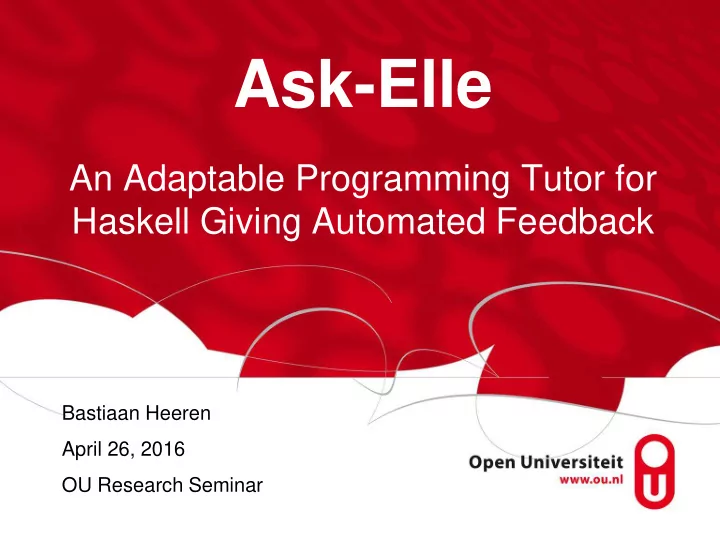

Ask-Elle An Adaptable Programming Tutor for Haskell Giving Automated Feedback Bastiaan Heeren April 26, 2016 OU Research Seminar
2. exercise description 4. high-level hint 5. bottom-out hint 3. student program 1. list of exercises
Why use an ITS? Evaluation studies have indicated that: ITS with stepwise development is almost as effective as a human tutor (VanLehn 2011) More effective when learning how to program than “on your own” with compiler, or pen and paper (Corbett et al. 1988) Requires less help from teacher while showing same performance on tests (Odekirk-Hash and Zachary 2001) Increases self-confidence of female students (Kumar 2008) Immediate feedback of ITS is preferred over delayed feedback common in classroom settings (Mory 2003)
Type of exercises Determines how difficult it is to generate feedback Classification by Le and Pinkwart (2014): − Class 1: single correct solution − Class 2: different implementation variants − Class 3: alternative solution strategies Ask-Elle offers class 3 exercises
Ask-Elle’s contribution The design of a programming tutor that: 1. offers class 3 exercises 2. supports incremental development of solutions 3. automatically calculates feedback and hints 4. allows teachers to add exercises and adapt feedback Our approach: strategy-based model tracing property-based testing compiler technology for FP languages
Overview Session: student & teacher Design Experiment 1: assessment Experiment 2: questionnaire Experiment 3: student program analysis Conclusions
Student session Example 32 + 8 + 2 = 42 we follow the foldl approach Available hints:
Student session Session a hole (expression)
Student session Session (continued) standard compiler error by Helium
Teacher session Model solutions Teachers can supply model solutions
Teacher session Recognising solutions Aggressive normalisation Semantic equality of programs is undecidable For example: can be recognised by:
Teacher session Adapting feedback description of the solution textual feedback annotations enforce use of library function alternative definition
Teacher session Properties Used for reporting counter-examples f is the student program round-trip property
Design Ask-Elle’s design
Experiment 1: Assessing Student Programs
Assessing student programs Automated assessment Many tools use some form of testing Problems with testing: how do you know … 1. you have tested enough (coverage)? 2. that good programming techniques are used? 3. which algorithm was used? 4. the executed code has no malicious features? Strategy-based assessment solves these problems
Assessing student programs Classification (by hand) Good: proper solution (correctness and design) Good with modifications: solutions augmented with sanity checks (e.g. input checks) Imperfect: program contains imperfections: e.g. superfluous cases, length (x:xs) - 1 First-year FP course at UU (2008) − 94 submissions for fromBin − 64 are good, 8 good with modifications (total: 72)
Assessing student programs Results 62 of 72 (86%) are recognized based on 4 model solutions No false positives Model solutions: foldl (18), tupling (2), inner product (2) Explicit recursion (40), which is simple but inefficient Example of program that was not recognized:
Experiment 2: Questionnaire
Questionnaire Questionnaire FP bachelor course at UU (September 2011) with 200 students Approx. 100 students used the tutor in two sessions (week 2) Forty filled out the questionnaire (Likert scale, 1-5) Experiment was repeated for: − FP experts from the IFIP WG 2.1 group − Student participants of the CEFP 2011 summer school
Questionnaire Results
Questionnaire Evaluation of open questions Remarks that appear most: Some solutions are not recognised by the tutor Incorrect solution? Give counterexample The response of the tutor is sometimes too slow Special ‘search mode’
Experiment 3: Student Program Analysis
Analysis Classification (by Ask-Elle) Correctness: For full program: expected input-output behaviour For partial program: can be refined to correct, full program Categories: Compiler error (Error) Matches model solution (Model) Counterexample (Counter) Undecided, separated into Tests passed and Discarded
Analysis Questions related to feedback quality How many programs are classified as undecided? How often would adding a program transformation help? How often would adding a model solution help? How often do students add irrelevant parts? How many of the programs with correct input–output behaviour contain imperfections (hard to remove)? How often does QuickCheck not find a counterexample, although the student program is incorrect? (precise answers in paper)
Analysis Correct (but no match) Cases: 1. The student has come up with a way to solve the exercise that significantly differs from the model solutions 2. Ask-Elle misses some transformations 3. The student has solved more than just the programming exercise (e.g. extra checks) 4. The student implementation does not use good programming practices or contains imperfections
Analysis Incorrect (but no counterexample) Cases: 1. Tests passed. All test cases passed. By default, 100 test cases are run with random values for each property. 2. Discarded. Too many test cases are discarded. By default, more than 90% is considered to be too many.
Analysis Results September 2013 at UU: 5950 log entries from 116 students Exercise attempts (last program) and interactions Recognized: Model / (Model + Passed + Discarded) Classified: (Model + Error + Counter) / Total
Analysis Missing program transformations Analysis (by hand) of 436 interactions in ‘Tests passed’: Remove type signature (94) Recognise more prelude functions and alternative definitions (37); followed by beta-reduction (39) Formal parameters versus lambda’s, eta-conversion (75) Alpha-conversion bug (48), wildcard (19) Better inlining (26) Substituting equalities a==b (26) Removing syntactic sugar (22) (…)
Analysis Updated results original results
Conclusions Ask-Elle supports the incremental development of programs for class 3 programming exercises Feedback and hints are automatically calculated from teacher-specified annotated model solutions and properties Main technologies: strategy-based model tracing and property-based testing. With improvements from last experiment: − recognise nearly 82% of (correct) interactions − classify nearly 93% of interactions
Future work Other programming languages and paradigms Measure learning effects and effectiveness Draw up a feedback benchmark Abstract model solutions (recursion patterns) Contracts for blame assignment Systematic literature review on feedback in learning environments for programming − Part 1 to be presented at ITiCSE 2016 (69 tools)
Recommend
More recommend